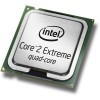- Qualcomm Launches Snapdragon 4 Gen 2 Mobile Platform
- AMD Launches Ryzen PRO 7000 Series Mobile & Desktop Platform
- Intel Launches Sleek Single-Slot Arc Pro A60 Workstation Graphics Card
- NVIDIA Announces Latest Ada Lovelace Additions: GeForce RTX 4060 Ti & RTX 4060
- Maxon Redshift With AMD Radeon GPU Rendering Support Now Available
Intel Core 2 Extreme QX9770 Performance Preview

We took a look at Intel’s first 45nm desktop offering a few weeks ago and already have a preview of it’s successor. The QX9770 is equipped with a 3.2GHz frequency and is the first Intel CPU to support a 1600MHz Front-Side-Bus. Read on to see how it compares to the rest of our fleet.
Page 11 – Temperatures & Power Consumption
As our processors become faster and more robust, power consumption can also increase. Thanks to the focus on efficiency though, current processors can use less power than models seen just two years ago. While our QX6850 and QX9650 had TDPs of 130W, the QX9770 is the first processor in a while to have a TDP that goes beyond that spec, at 136W.
We use a Kill-A-Watt in order to capture the wattages. At each setting, we eye the meter for around a minute in order to grab an average. Normally, the wattage will stay the same for the entire minute, once the computer either sits idle for a minute or two, or if the benchmarks are in full swing. Idle results are grabbed after the PC sits idle for two minutes, while the 50% CPU is with 50% of the available cores being stressed using Cinebench R10. This would simulate more intensive applications that wouldn’t make use of more than half of the available processing power.
Lastly, for a full load recording, we run a copy of Cinebenchs multi-thread test, effectively keeping usage at a constant 100%. After a minute of watching the meter, the highest wattage point reached is recorded.

When comparing the QX9650 to the QX6850, the differences are in favor of the newer processor. Good thing. More speed, more efficiency, lower power. Our QX9770 uses more power than the rest of the bunch, which might have to due with the fact that we needed to boost our NB voltage a fair amount. I’ll explain this better shortly.
Processor Temperatures
When you cram four cores under the same IHS that usually houses two, temperatures are bound to skyrocket. This really means one thing… that you do not want to use a cheap air cooler. A high-quality air cooler should suffice, but for the enthusiast, water-cooling is really the only way to go.
For grabbing temperature information, I stick to using Everest 4.0, since it seems quite accurate. However, when bringing it up with Intel earlier this year, we were told that there is no way for any application to have a completely accurate reading for Quad-Core temperatures, Everest and CoreTemp included.
Quad-Cores utilize what’s called a Digital Temperature Sensor, DTS for short, which provides an offset from the Prochot trip temperature. If the processor is 12°C away from activating the TCC and Prochot, then the reported temperature, behind the scenes, will be -12°C. Intel states that the reason exact temperatures cannot be determined is because they have not defined the precise temperature at which the TCC is activated. How it’s activated at all, I am not sure.
Temperatures gathered with quad-cores shouldn’t be considered accurate with any application, which leads me to wish that Intel offered a tool for finding the precise temperature. If for whatever reason the CPU does get too hot, which I assume to be when the TCC and Prochot is activated, a reverse-EIST effect will occur, where the processor will automatically reduce the multiplier to 6 in order to reduce the clock speed and in turn, the temperature.
 Room Temperatures E6600 @ 68°F, Q6600, QX6850, QX9650 @ 70°F, QX9770 @ 74°F, E6750 @ 76°F |
Because I perform testing in a room that has no temperature control, the room temp can change throughout the day. Since our testing occurred over the course of a few days (due to a total rerun of tests on all processors), temperatures changed a fair amount. Even still, at 74°F room temp, the QX9770 did not inch over 50°C.
Support our efforts! With ad revenue at an all-time low for written websites, we're relying more than ever on reader support to help us continue putting so much effort into this type of content. You can support us by becoming a Patron, or by using our Amazon shopping affiliate links listed through our articles. Thanks for your support!





